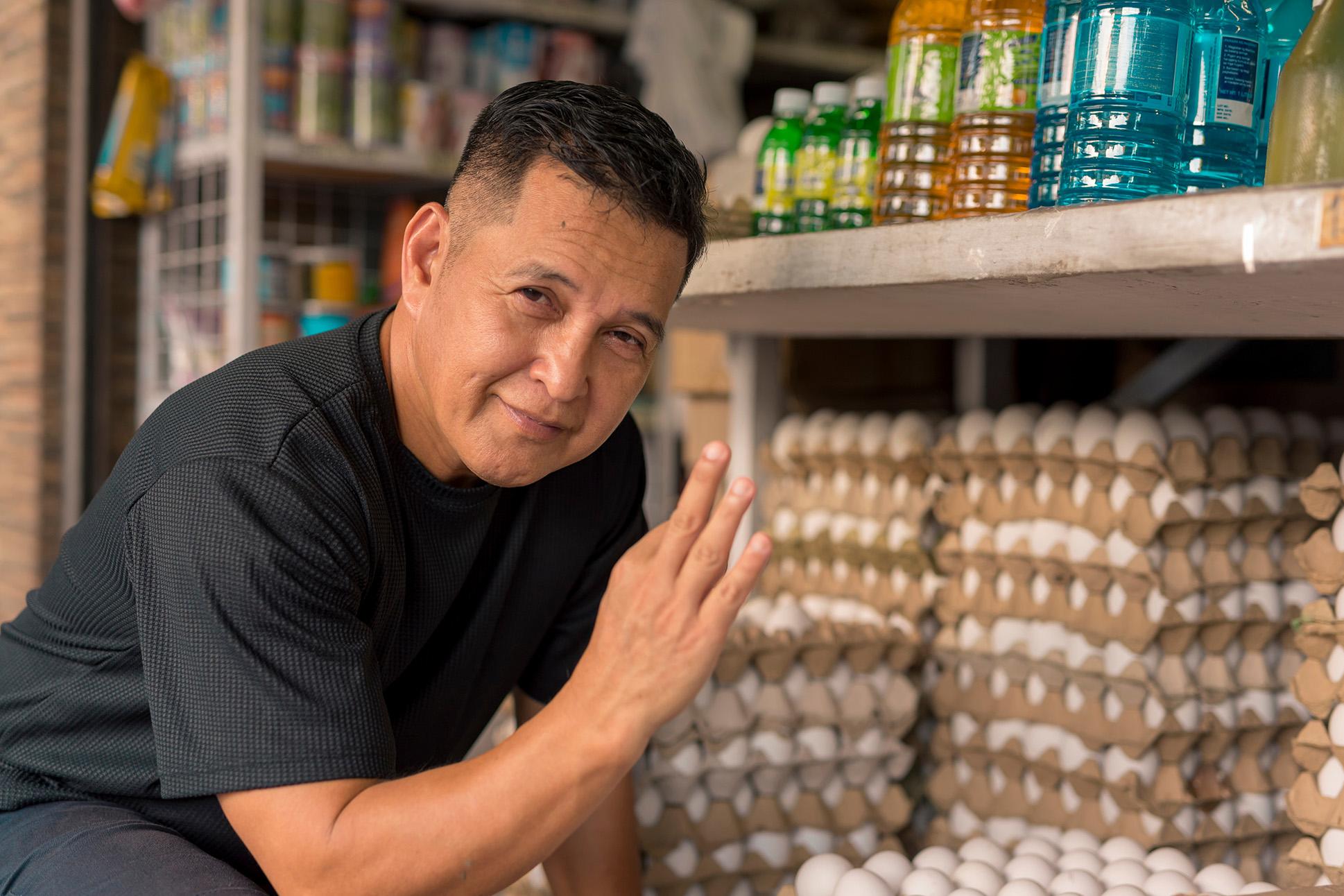The sari-sari store business is a vital part of the Philippine economy. But in today’s digital age, it might be hard to imagine how the “pabili sa tindahan” culture still holds strong.
The Philippine e-commerce scene still relies heavily on sari-sari stores, highlighting that even in the age of technology, convenience is often just a short walk away. Understanding this deeply rooted aspect of Filipino business culture, particularly how to establish a sari-sari store, is crucial for success in the Philippine business landscape.
What is a sari-sari store, and why is it important?
What kind of business is a sari-sari store exactly? It’s a micro-retail venture rooted in accessibility, community, and adaptability.
A sari-sari store in the Philippines isn’t just a one-stop shop. It’s a vital lifeline for the neighborhood with everyday essentials. These small stores sell just about everything under the sun, from snacks and condiments to sachets of shampoo, batteries, and even screws.
Most Filipinos live on a daily budget, making it impractical to buy in bulk from grocery stores or supermarkets. Sari-sari stores offer items in smaller quantities or “tingi”, making it easier for customers to stretch their pesos. This also allows business owners to add a small markup, typically ₱1 to ₱2 per portion. It won’t hurt affordability.
The sari-sari store also mirrors the way Filipinos cook and live. Local dishes like halo-halo and sinigang need many ingredients. If you run out of one, the sari-sari store is nearby to help.
Why is a sari-sari store a good business?
While considered a small business, about 94% of Filipinos rely on sari-sari stores for daily needs. This creates steady foot traffic and regular sales. Opening a sari-sari store in the Philippines is still very profitable because Filipino buying habits have remained relatively unchanged. Despite the rise of online shopping, many Filipinos still rely on their local sari-sari stores for quick, everyday needs, offering unmatched convenience right in the neighborhood.
In 2023 alone, sari-sari stores generated PHP 8 billion in sales, underscoring their significant impact. By 2024, over 511,000 new registrations and renewals in the wholesale and retail store sector showed that these businesses aren’t just surviving, they’re thriving.

Online shopping platforms like Lazada and Shopee have become popular. However, delivery times continue to be an issue. In Metro Manila, it takes 4 to 6 days. Outside the city, especially in rural areas, it can take 7 to 12 days. This delay highlights the value of sari-sari stores. They provide fast and reliable access to immediate needs.
Beyond profits, sari-sari stores play a vital role in promoting economic inclusion. Many of these are led by women. They help Filipina entrepreneurs support their families and stay close to their communities.
Sari-sari stores are a smart choice for starting a business in the Philippines. They meet daily needs and have great potential for entrepreneurship. Plus, they can support the long-term financial goals of local business owners.
Key considerations for starting a sari-sari store business
Starting a sari-sari store is more than setting up a shop. It’s about building a strong foundation. This foundation helps your store thrive in the community. Here are some sari-sari store tips for you:
Develop a business plan
Creating a solid business plan is a crucial first step when learning how to start a sari-sari store. Sari-sari stores may appear informal, but they require careful planning to succeed. Many stores can be found on the same street, often just a house or two apart.
A well-planned approach helps you manage daily tasks more easily. It also helps you make smart choices and stay ahead of the competition. Key components include:
- Market analysis: Know your neighborhood's demographics. Check the demand for sari-sari store products within your target market. Are there schoolchildren nearby? Should you stock up on supplies? Is the wet market far? Should you offer vegetables or frozen goods?
- Marketing strategy: Identify how you’ll attract and retain customers. Will you offer credit "utang"? Can you differentiate through promos, personalized service, or “suking tindahan” discounts to encourage repeat customers? Do you provide space for your regulars to “tambay” around your store after their purchase?
- Financial plan: Estimate your startup capital, sales projections, and pricing strategy. Is your markup sustainable and competitive with those of nearby sari-sari store businesses?
- Operations plan: Define store hours, coordinate with suppliers, and manage inventory. What’s your restocking schedule? Do you close midday? How do you handle peak hours?
- Risk Management: Prepare for challenges such as changing demand, supplier delays, or seasonal fluctuations. Have a backup plan for emergencies. Local competition is tough, and the margin for error is slim.
A strong business plan is key for every successful sari-sari store in the Philippines. The more you think about it at first, the better your chances for growth and sustainability.
Determine your capital requirements
A sari-sari store might seem small, but don’t underestimate the startup costs. Depending on your product mix, the initial capital typically ranges from ₱15,000 to ₱25,000.
Smart budgeting is key to learning how to manage sari-sari store operations effectively. Focus on:
- Startup costs: Expenses for store setup, such as shelves, signage, initial inventory, and basic tools like weighing scales or cash boxes.
- Working capital: Funds for restocking fast-moving items in a sari-sari store, utilities, and routine maintenance.
Knowing your capital needs from the start helps prevent cash flow issues. This way, you can run your operations efficiently every day.
Legal requirements
Following local laws keeps your sari-sari store in the Philippines running smoothly. It also helps you avoid fines. Key legal steps include:
- Barangay business permit: Register with your local barangay. This is usually the first permit small neighborhood stores need.
- BIR business registration: Register your business with the Bureau of Internal Revenue. If your annual gross sales are under ₱3,000,000 and you're not VAT-registered, you usually pay a 3% tax. This is cut to 1% until June 30, 2023, thanks to the CREATE Law.
- DTI permits: Sari-sari stores with specialty products will need permits from the Department of Trade and Industry (DTI).
Obtaining the necessary permits ensures your legal safety. It also builds trust with customers and boosts your business's credibility.
Related: How to start and register a business in the Philippines? A 2025 guide
Finding the right location
The success of your sari-sari store business heavily depends on where you set it up. While many stores operate from the owner's home, it is still important to consider:
- Foot traffic: Pick a location close to schools, transit hubs, or busy streets. This will help attract more walk-in customers.
- Neighborhood demographics: Know your community’s needs. Adjust your sari-sari store products to fit local demand.
- Store layout: Organize your store for visibility and accessibility. Customers appreciate being able to see what is available at a glance.
- Signage and Branding: Use clear, catchy signage to leave a lasting impression. Creative business names and puns, like a Filipino store named “7-evelyn” (a play on “7-Eleven”), grab attention and build identity.
A great location and a friendly setup can boost sales and build customer loyalty.
iba talaga utak ng pinoy👏👏👏 Okeyyy keeeyo! Ang nag iisang Seven Evelyn #Apagan1Seawall I ❤️ 🇵🇭
Posted by Chad Gray Jet Pazaol on Saturday, November 30, 2019
Product selection and inventory management
Effective inventory management and wise product selection are essential to maintain the profitability of a sari-sari store. Stocking the right items and managing them well keeps customers happy. It also reduces waste and boosts sales.
Choosing sari-sari store products
When learning how to start a sari-sari store, selecting the right and quality products is crucial. Focus on:
- Choosing your products: Household essentials like soap, detergent, and basic medicines that meet everyday needs.
- Fast-moving items in a sari-sari store: Snacks, canned goods, cooking condiments such as cooking oil, soft drinks, coffee, toiletries, and school supplies that sell quickly and keep customers returning.
- Seasonal products: Serve summer favorites like halo-halo and ice candy. Also, offer warm treats like champorado in cooler months to draw in more customers.
- Unique local demand: Customize your inventory to your neighborhood. Sari-sari store owner Rizza Mae Duran boosted sales by adding kid-friendly snacks. She responded to local families' needs by offering treats like graham balls.
- Distribution opportunities: Larger sari-sari stores often serve as distribution hubs for brands like Coca-Cola and RC, supplying smaller neighborhood stores.
Effective inventory management
Good inventory management is key to how to manage sari-sari store operations successfully.
- Inventory levels: Use spreadsheets to maintain accurate stock records. Manual logs are effective inventory systems, but they can be more challenging to maintain over time.
- First-In, First-Out (FIFO) system: Sell older stock before new shipments. This helps reduce waste, especially for perishable goods.
- Expiration management: Regularly check expiration dates to avoid selling spoiled products.
- Slow movers: Monitor product flow and sales volume closely. Stop selling items that don’t sell well. This helps to free up inventory space and capital.
Managing suppliers and reorders
Maintaining strong supplier relationships and timely reordering keeps your store running smoothly.
- Build relationships with suppliers. Work with trusted local partners to reduce transportation costs. After a year or more of partnership, don’t be shy to negotiate for better prices or discounts. You’ll be surprised at how local suppliers are willing to give discounts to keep their strategic resellers.
- Set strategic reorder points: Find the best time to restock popular items. This helps avoid running out of stock. Running out of essentials can push regular customers to shop elsewhere. This affects your store’s reputation and sales.
- Restock regularly: Keep a schedule to refill bestsellers. This helps avoid missed sales.
Choosing the right products and handling inventory are key to your sari-sari store's growth. This approach helps build strong customer loyalty.
Financial management and pricing
Effective financial management and strategic pricing are crucial for maintaining a profitable and sustainable sari-sari store.
Budgeting and record-keeping
When learning how to manage a sari-sari store's finances, it is important to:
- Keep business and personal funds separate: Sari-sari stores are usually family-owned. However, mixing family money with store funds can cause confusion. This helps you keep clear financial records.
- Use accounting tools: Simple spreadsheets or basic apps can track daily sales, expenses, and cash flow. This helps you manage your business more effectively.
- Maintain clear records: Effective bookkeeping enables you to track profit margins, manage expenses, and plan for future growth.
Setting product prices
Pricing your products strategically can boost sales and customer loyalty. Consider:
- Competitive pricing: Check local sari-sari stores to find prices that are appealing and still make a profit.
- 10% markup rule: Begin by adding a 10% markup on wholesale costs. This helps cover expenses and earn profit while avoiding high prices. Review this strategy first and determine if you need to adjust your markup based on customer feedback and market competition.
- Customer Affordability: Adjust your markup to align with your community's purchasing power. This way, customers will keep coming back.
How do you market your sari-sari store business?
While not all sari-sari store owners may create websites, having an online presence, even in local Facebook groups or messaging platforms, can already make a difference.
Set up an online presence
Building an online presence can boost foot traffic to your sari-sari store. It helps nearby customers find you easily through local searches.
- Local online presence: Look at 168mall. This group of Filipino local stores grew by building a solid online presence. You can further boost their strategy by getting a .ph domain from platforms like GoDaddy, as it helps increase your visibility and rank higher in local searches.
- Professional online suite: Platforms like GoDaddy offer business email and Office 365 tools. Through these tools, you can communicate effectively with suppliers and customers. This fosters trust and credibility, making business dealings more seamless and efficient.
- Local branding: A dedicated website or professional email boosts your sari-sari store's image. It helps your store stand out online and builds trust in the community.
Social media marketing
Social media keeps your store at the forefront of people's minds. It invites new and returning visitors to drop in with timely posts and promotions.
- Social media platforms: Use Facebook, Instagram, and TikTok to promote your store. Funny day-to-day experience works well with the Filipino audience. Use targeted local content to strengthen community engagement.
- Engaging content: Share product highlights, special deals, and customer reviews to draw in followers and boost repeat visits.
- Customer interaction: Respond promptly to comments and messages to build strong relationships and boost positive word-of-mouth referrals.
Collaborations and partnerships
Partnering with nearby businesses and engaging with the local community can draw more people to your sari-sari store and turn it into a go-to spot in your area.
- Local partnerships: Collaborate with suppliers, neighboring stores, or community groups. Joining local Facebook groups in your barangay or city is a smart way to start cross-promotions and co-marketing.
- Community engagement: Showcase your store’s unique offerings, such as bill payment and telco load services, to become a valued neighborhood hub.
- Business growth: Utilize platforms like Growsari. They provide inventory financing, on-demand product choices, and integrated microservices. These tools help transform your sari-sari store into a comprehensive community service center.
Ready to start your sari-sari store in the Philippines?
To build a successful sari-sari store, start with careful planning. Choose products wisely. Use steady financial and marketing strategies. Whether you're a first-time entrepreneur or reviving a family store, a sari-sari business can be both fulfilling and financially rewarding with the right strategy.
Every step matters, from picking popular local products to handling inventory wisely. Practicing good financial discipline and setting competitive prices ensures your business stays profitable. Build an online presence. Connect with your community on social media. Seek local partnerships. This way, your sari-sari store can grow into a trusted brand, not just a convenience store.
As you grow your sari-sari business, GoDaddy is here to support you. Get a .ph domain, set up a pro email, and use tools like Office 365. These strategies will help your store stand out in today’s digital economy. Small homegrown businesses can thrive in a tough market with the right tools and support.
Looking to kick off your journey? Visit GoDaddy's blog for expert tips, real stories, and advice on building a successful business in the Philippines. Many resources are ready for you. They are made just for local entrepreneurs like you.









